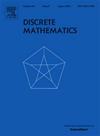图的谱半径、连通性和边连通性的统一方法
IF 0.7
3区 数学
Q2 MATHEMATICS
引用次数: 0
摘要
对于两个整数 r≥2 和 h≥0,图 G 的 h-extra r-component connectivity κrh(G)定义为:将 G 断开的顶点子集 S 的最小大小,使得 G-S 中至少有 r 个相连的分量,且每个分量至少有 h+1 个顶点。用 Gn,δκrh 表示具有 h+1 个顶点的 n 个顶点图的集合,这些图具有 h+1 个连通分量κrh 和最小阶数δ。 Brualdi 和 Solheid(1986 年)提出了以下关于谱半径的问题[2]:给定一组图 S,求 S 中图的谱半径上限,并描述达到最大谱半径的图的特征。范、顾和林(2024)[7] 回答了 r≥2 和 h=0 的问题。本文完全解决了 r≥2 和 h≥1 的问题。这意味着之前在连通性和边缘连通性方面的一些结果。本文章由计算机程序翻译,如有差异,请以英文原文为准。
A unified approach to the spectral radius, connectivity and edge-connectivity of graphs
For two integers and , the h-extra r-component connectivity of a graph G is defined as the minimum size of a subset S of vertices whose removal disconnects G, such that there are at least r connected components in and each component has at least vertices. Denote by the set of n-vertex graphs with h-extra r-component connectivity and minimum degree δ. The following problem concerning spectral radius was proposed by Brualdi and Solheid (1986) [2]: Given a set of graphs , find an upper bound for the spectral radius of graphs in and characterize the graphs in which the maximum spectral radius is attained. We study this question for where and . Fan, Gu and Lin (2024) [7] answered the question for and . In this paper, we solve this problem completely for and . Moreover, we also investigate analogous problems for the edge version. This implies some previous results in connectivity and edge-connectivity.
求助全文
通过发布文献求助,成功后即可免费获取论文全文。
去求助
来源期刊

Discrete Mathematics
数学-数学
CiteScore
1.50
自引率
12.50%
发文量
424
审稿时长
6 months
期刊介绍:
Discrete Mathematics provides a common forum for significant research in many areas of discrete mathematics and combinatorics. Among the fields covered by Discrete Mathematics are graph and hypergraph theory, enumeration, coding theory, block designs, the combinatorics of partially ordered sets, extremal set theory, matroid theory, algebraic combinatorics, discrete geometry, matrices, and discrete probability theory.
Items in the journal include research articles (Contributions or Notes, depending on length) and survey/expository articles (Perspectives). Efforts are made to process the submission of Notes (short articles) quickly. The Perspectives section features expository articles accessible to a broad audience that cast new light or present unifying points of view on well-known or insufficiently-known topics.
 求助内容:
求助内容: 应助结果提醒方式:
应助结果提醒方式:


